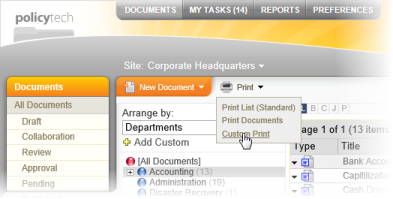
Important: You will see this print option only if you've been assigned the document control administrator or report manager permission.
The Custom Print feature uses a different method of selecting documents (not the document list) and offers more options for what to print.
Important: By default, only documents assigned the All Users (default) security level are displayed in the Available Documents box. To display and have the option to select documents assigned the Restricted - High or Restricted - Severe security level, click Show Restricted Documents. Restricted document titles are preceded by the lock icon ( ) and are displayed in red font.
) and are displayed in red font.
Important: Making changes in the Document Arrangement area directly affects what is printed or exported with the Print Display Table options.
To change which columns of information are displayed in the document list, click Show/Hide Columns, and then select what you want added and deselect what you want removed.
Important: Changing what is displayed in the Document Arrangement list does not affect output when Print Documents is selected, but it does affect the output for Print Display Table. With Print Display Table and Standard selected, deselecting the following columns hides them in the Document Arrangement list, but it does not remove them from the standard display table: Reference #, Ver #,Review Interval, Document Owner, URL, Categories; however, all of the date column selections do affect the contents of the standard display table. With Print Display Table and Microsoft Excel Raw selected, all column changes you make directly affect what is included in the exported display table file.
Note: The Security Details option functions differently than the other Show/Hide Columns options. First, it is only selectable if Microsoft Excel Raw is selected. Second, it causes two columns to be added to the display table: Allowed Access Type and Allowed Access. These two columns will contain information only for documents that have the Restricted - High or Restricted - Severe security level assigned, and only if one or more other allowed users are selected (for details on security levels, see Step 7: Security). The Allowed Access Type column shows how other allowed users were selected (by department, by job title, or by readers), and the Allowed Access column shows the departments, job titles, and readers that were selected. Notice in the example below that a separate row is included for each of a document's Allowed Access entities that were selected.
By default, the document sort order in the report is ascending by title. To change what the documents are sorted by, click a different column header. Click the same column header again to reverse the sort order.
Note: Changes to the document sort column and sort order directly affect both Print Display Table outputs.
Important: PolicyTech™ opens and prints each selected document one after the other. This may take several minutes if many documents are selected. Do not attempt to work with any open document until the printing process has completely finished.
The last thing to be printed is the table of contents page, at which time you'll see the message displayed below.
To use the default table of contents that has already been printed, click Cancel, which closes the table of contents.
To edit the default table of contents page, click OK, and then make changes as you would with any other Word document within PolicyTech. When finished, print the modified table of contents from within Word.
If Standard is currently selected, the report opens in a separate browser window.

If Microsoft Excel Raw is selected, at the Windows system prompt, open or save the display table file.
